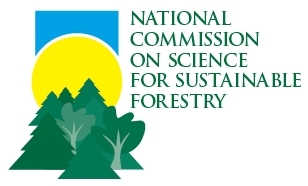Beyond Old Growth: Preface
| Topics: |
Contents
The Commission's Role: Reaching Out to Stakeholders
The National Commission on Science for Sustainable Forestry (NCSSF) was created in 2001 to improve the scientific basis for sustainable forestry practices in the United States. NCSSF sponsors work of the highest technical quality that is relevant to the urgent needs of forest managers, practitioners and policymakers. Since it began its work, NCSSF has interacted with these primary target audiences to identify work that will improve the scientific basis for sustainable forestry and biodiversity.
The Commission also has received extensive external input from stakeholders—people in government, industry, academia, and environmental organizations that influence decisions about the future of sustainable forestry or will be affected by the consequences of those decisions. The Commissioners have responded by hosting meetings to help these stakeholders identify areas of consensus and divergence. One premise that has emerged is that sustainable forestry should recognize the unique role and value of older trees and forests.
In 2005, NCSSF held five regional workshops designed to define characteristics, functions, and strategies for protecting and perpetuating older forests, including mature stands of smaller trees with less complexity than similar old-growth stands as well as old growth itself.
The workshops were held in major forested regions across the United States—the Northeast, the Great Lakes, the Southeast, the Pacific Northwest, and the Southwest. Workshop participants examined the state of knowledge of older forests and addressed the questions:
- What is the status and extent of older forests in the region?
- What, if any, old-growth enhancement activities are desirable and possible?
- What action steps/plans are appropriate on public and private lands?
- How do forest certification systems treat older forests and how can the science base for this be strengthened?
- What thresholds exist that might set boundaries on the desired extent of older forests?
The workshops were conducted in 2005-06, and final reports were submitted to NCSSF. In October 2006, the project leaders met with Commission members and staff for a workshop to discuss how to integrate the findings that came out of the regional workshops. This publication is the result of those discussions.
The following pages synthesize some overarching commonalities and significant differences among the five regions that emerged from the workshops. They are highlights and examples, not a compilation or comprehensive overview of all of the workshop findings. More detailed information can be found in the individual workshop reports. These reports are available on the NCSSF web site.
Commission Members
Joyce Berry, PhD Commission Chair Vice President for Advancement and Strategic Initiatives, Colorado State University
Greg Aplet, PhD Senior Forest Scientist The Wilderness Society
V. Alaric Sample, PhD President Pinchot Institute for Conservation
Jim Brown Jim Brown Consulting Forestry, LLC Oregon State Forester, 1986-2003
Ann Bartuska, PhD Deputy Chief, Research & Development USDA Forest Service
Norm L. Christensen, PhD Professor of Ecology Nicholas School of the Environment Duke University
Nils Christoffersen Executive Director Wallowa Resources
John C. Gordon, PhD Pinchot Professor of Forestry Emeritus School of Forestry and Environmental Studies Yale University
Alan A. Lucier, PhD Senior Vice President National Council on Air & Stream Improvements
David Perry, PhD Professor Emeritus Oregon State University
H. Ronald Pulliam, PhD Regents Professor of Ecology University of Georgia
Harold Salwasser, PhD Dean, College of Forestry Oregon State University
Scott Wallinger Senior Vice President, Retired Mead WestVaco, Forest Science Laboratory
NCSSF Program Director
Chris Bernabo, PhD Director, Center for Science Solutions National Council for Science and the Environment
Past Commission Members
Bruce J. Cabarle, PhD Director, Global Forestry Programs World Wildlife Federation, 2001-2004
Charles H. Collins Managing Director, The Forestland Group, LLC., 2001-2002
Wallace Covington, PhD Regents’ Professor and Director Ecological Restoration Institute Northern Arizona University, 2001-2003
Sharon Haines, PhD Manager of Sustainable Forestry, International Paper, 2001-2007
Phil Janek, PhD Chief Operating Officer USDA Forest Service Retired, 2001-2003
Mark Schaefer, PhD Executive Director NatureServe, 2001-2004
Mark Schaffer, PhD Program Director for the Environment Doris Duke Charitable Foundation, 2001-2004
Tom Thompson Deputy Chief, National Forest System USDA Forest Service, 2003-2004
The Workshops
Northeast
John M. Hagan, PhD
Project Leader
Manomet Center for Conservation Sciences
Brunswick, Maine
Great Lakes
Nancy Langston, PhD
Project Leader
University of Wisconsin-Madison
Madison, Wisconsin
Southeast
Robert J. Mitchell, PhD
Project Leader
Joseph W. Jones Ecological
Research Center
Newton, Georgia
Pacific Northwest
Thomas A. Spies, PhD
Project Leader
Pacific Northwest Research Station
USDA Forest Service
Corvallis, Oregon
Southwest
William Wallace Covington, PhD
Project Leader
Northern Arizona University
Flagstaff, Arizona
The Report
Much of the substance and language of this report was taken from project overviews and other documents written by the project leaders.
John Gordon, a member of the Commission who is NCSSF’s Old Growth Project Steward, supervised the development of the report. He also revised draft versions in response to review and comment by the project leaders and added a substantial amount of content. He is Pinchot Professor of Forestry and Environmental Studies Emeritus, Yale School of Forestry and Environmental Studies.
Henry Lansford was writer/editor for the report. He is an editorial consultant to NCSSF.
Chris Bernabo is the NCSSF Program Director. For more information about NCSSF, contact him at the National Council for Science and the Environment, 1101 17th Street, NW, Suite 250, Washington, DC 20036, chris@ncseonline.org chris@ncseonline.org, or go to http://www.NCSSF.org.
|
|
